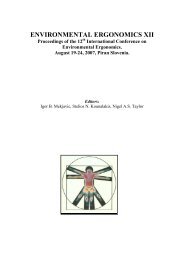Download this issue - Loughborough University
Download this issue - Loughborough University
Download this issue - Loughborough University
Create successful ePaper yourself
Turn your PDF publications into a flip-book with our unique Google optimized e-Paper software.
20 the research & enterprise view<br />
Investment in sport and exercise<br />
medicine is on the rise. New<br />
multi-million pound institutes of<br />
expertise have been established,<br />
including one at <strong>Loughborough</strong><br />
<strong>University</strong>. These ‘hubs’ bring together<br />
clinicians, scientists, engineers and<br />
researchers, all under one roof, experts<br />
such as <strong>Loughborough</strong>’s Professor of<br />
Musculoskeletal Biology, Mark Lewis.<br />
Their compelling, collaborative research<br />
could result in therapies that will improve<br />
the quality of life for millions of people,<br />
and help prevent diseases related to<br />
inactivity.<br />
Professor Lewis explained: “Advances in<br />
t<strong>issue</strong> engineering, regenerative medicine<br />
and stem cell technology mean we can now<br />
‘make’ a piece of muscle that mimics how<br />
human muscle behaves. Our in vitro muscle<br />
models are around two centimetres long.<br />
“There is potential to grow muscle for<br />
transplants and reconstruction. We are<br />
working with orthopaedic surgeons to look<br />
at how we can attach muscle to bone for<br />
reconstructive surgery and sports injuries.<br />
We are also exploring how to grow muscles<br />
and nerves together.”<br />
He added: “During the past three to<br />
five years we have got to the point at<br />
<strong>Loughborough</strong> where we are really starting<br />
to push and interrogate the systems we have<br />
built over previous decades. We are moving<br />
forward at some pace.”<br />
The challenge is to<br />
use the huge potential<br />
of exercise as a<br />
therapeutic tool.<br />
To make muscle perform in ‘mini gyms’ in<br />
the laboratory, the team uses two systems.<br />
One is a mechanical system, where a<br />
stepper motor is attached to the muscle and<br />
‘stretches’ it. The motor can be set at any<br />
variable researchers choose, so they can<br />
really exercise the muscle hard and introduce<br />
lots of different regimes that simulate<br />
different types of exercise or performance.<br />
The other system used to test muscle<br />
performance is to use electrodes (an electric<br />
current) to stimulate it, to make it ‘twitch’.<br />
Researchers can use these models to<br />
understand muscle physiology in the<br />
laboratory, but transferring <strong>this</strong> science<br />
to the wider population is where the real<br />
legacy lies.<br />
Professor Lewis said: “The challenge is<br />
to use the huge potential of exercise as<br />
a therapeutic tool. Whether it’s a cancer<br />
patient, a respiratory patient, a cardiac<br />
patient or a diabetic patient, if we can<br />
introduce exercise into their treatment<br />
programme, they will benefit, but it needs<br />
to be prescribed specifically.<br />
“A term that’s used a lot now is personalised<br />
medicine. It’s about designing medicines that<br />
are specific to an individual. What we need<br />
to be able to do is get evidence out there to<br />
medics. That’s what we are working towards,<br />
a personalised exercise prescription, so<br />
people exercise better and live longer.”<br />
Professor Lewis and his team are now in<br />
their final year of a three-year research<br />
programme which cost £500,000 to fund.<br />
He explained that one of the most rewarding<br />
parts of his research in recent years has been<br />
collaboration. He has been inspired through<br />
working with colleagues in world-class<br />
facilities such as the National Centre for<br />
Sport and Exercise Medicine, which has<br />
hubs in the East Midlands (at <strong>Loughborough</strong>),<br />
in London and Sheffield. Also with peers in<br />
respected institutions such <strong>University</strong> College<br />
London Hospitals (UCLH), and partnership<br />
work with UCL (<strong>University</strong> College London),<br />
Nottingham <strong>University</strong> and at Keele<br />
<strong>University</strong>, among others.<br />
Professor Lewis said: “You find yourself in<br />
a room with electrical engineers, chemical<br />
engineers, sport scientists and sports<br />
medics, bio-chemists and biologists who<br />
historically would never have had the<br />
occasion or opportunity to meet and talk. I<br />
find these interactions very exciting, and I’ve<br />
been surprised at just how well it all works.<br />
“Collaboration is the future. There are too<br />
many big <strong>issue</strong>s and not enough resources<br />
to give everyone a bit each. I believe<br />
collaboration is a paradigm for the way the<br />
world is going to be, going forward, certainly<br />
in research and development and in ideas<br />
and industry.”<br />
He concluded: “It’s people coming together<br />
with open hearts and open minds. And when<br />
you get the right people in a room, with the<br />
right mindsets, you can get lots done.”<br />
want to know more?<br />
Visit: www.lboro.ac.uk/departments/ssehs<br />
Contact: professor mark Lewis<br />
Email: hos-ssehs@lboro.ac.uk<br />
the research & enterprise view<br />
21

















